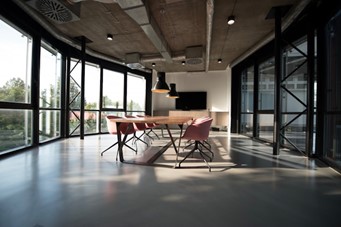
In the wake of the COVID-19 pandemic, remote work has become a prevailing trend, prompting a significant shift in how organizations approach office design. The traditional office space, once synonymous with rows of cubicles and rigid workstations, is now evolving to accommodate hybrid work models that balance remote and in-office work. David DeQuattro discusses below the transformative impact of remote work on office design trends, focusing on the integration of flexible workspaces, collaboration zones, and advanced technology to support a dynamic workforce.
Evolution of Office Design in the Remote Work Era
The rise of remote work has challenged conventional notions of office design, emphasizing flexibility, adaptability, and employee-centric environments. Here’s how office design trends are adapting to meet the needs of hybrid work models:
Flexible Workspaces
Traditional office layouts are giving way to flexible workspaces that cater to diverse work styles and preferences:
- Hot Desking and Hoteling: These concepts allow employees to reserve desks or workstations as needed, promoting mobility and flexibility.
- Activity-Based Working: Designing spaces based on different activities (e.g., quiet zones, collaborative areas, breakout spaces) enables employees to choose environments that best suit their tasks.
- Modular Furniture: Furniture that can be easily rearranged or reconfigured supports dynamic use of space, accommodating varying team sizes and project requirements.
Collaboration Zones
Effective collaboration remains essential despite remote work trends, prompting the creation of dedicated collaboration zones within office layouts:
- Meeting Rooms and Huddle Spaces: Equipped with video conferencing technology and interactive displays, these spaces facilitate virtual meetings and brainstorming sessions.
- Open Plan Designs: Open layouts promote spontaneous collaboration while ensuring accessibility to shared resources and amenities.
- Virtual Collaboration Tools: Integration of digital tools and platforms enhances remote collaboration, fostering seamless communication and idea exchange across distributed teams.
Technology Integration
Technology plays a pivotal role in supporting hybrid work environments, enabling connectivity and productivity regardless of physical location:
- Unified Communication Systems: Adoption of unified communication platforms (e.g., Microsoft Teams, Zoom) facilitates real-time collaboration, file sharing, and virtual meetings.
- IoT and Smart Office Solutions: IoT devices and sensors optimize space utilization, monitor environmental conditions, and personalize user experiences based on preferences.
- Cybersecurity Measures: Enhanced cybersecurity protocols protect sensitive data and ensure secure remote access to corporate networks and resources.

Adapting Office Spaces for Employee Well-being
Beyond functionality and efficiency, modern office design prioritizes employee well-being and satisfaction:
- Biophilic Design Elements: Incorporation of natural light, indoor plants, and outdoor views enhances cognitive function, reduces stress, and improves overall well-being.
- Ergonomic Furniture: Adjustable desks, supportive chairs, and ergonomic accessories promote comfort and mitigate physical strain during prolonged work hours.
- Wellness Rooms: Dedicated spaces for relaxation, meditation, or nursing mothers support holistic employee wellness.
Case Study: Google’s Flexible Office Strategy
Google has embraced hybrid work models by redesigning its office spaces to accommodate varying employee needs and preferences. The tech giant’s offices feature diverse work environments, including collaboration hubs, quiet zones, and recreational areas, fostering creativity, innovation, and employee engagement.
Conclusion
The shift to remote work has catalyzed a paradigm shift in office design, emphasizing flexibility, collaboration, and technology integration. By embracing flexible workspaces, dedicated collaboration zones, and advanced technology solutions, organizations can optimize productivity, foster creativity, and enhance employee satisfaction in hybrid work environments.
As businesses continue to navigate the evolving landscape of remote and hybrid work models, thoughtful office design will play a pivotal role in supporting organizational goals, promoting employee well-being, and maintaining a competitive edge in a rapidly changing world. By adapting office spaces to meet the needs of a dynamic workforce, organizations can harness the transformative potential of remote work while cultivating a culture of innovation and resilience.



